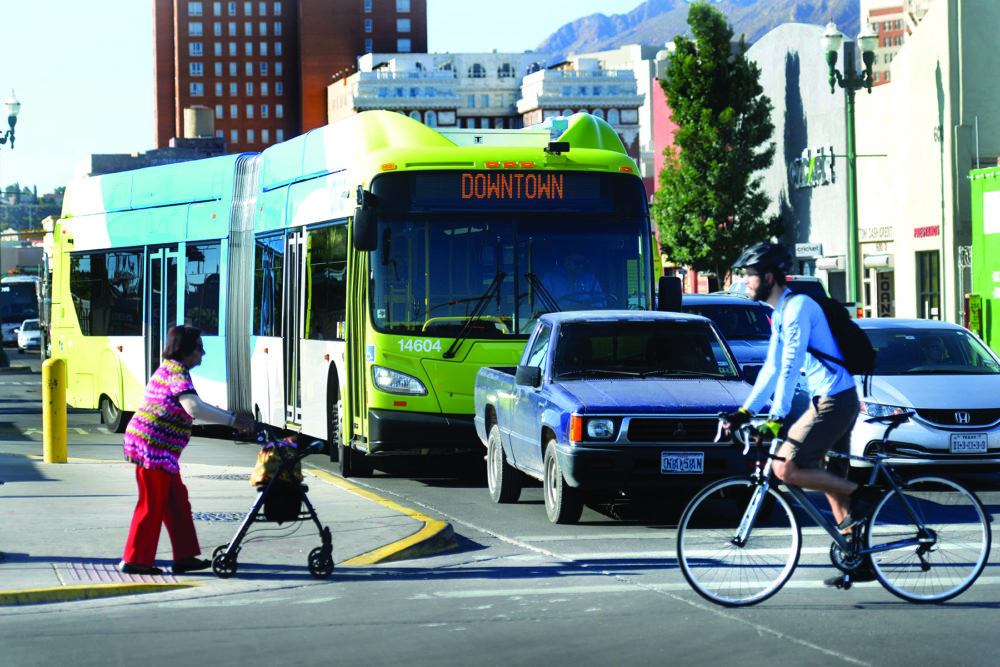Target Speeds — Pedestrians Action Plan
Description
Encourage use of target speeds that consider pedestrians, land use, and the roadway context (e.g., a target speed of 35 mph or less on arterials). Other examples are to provide design flexibility guidance for techniques to reduce operating speeds on surface streets; encourage use of tree-lined medians, bicycle lanes, and safe and attractive pedestrian crossings and walkways; and support use of traffic calming for local streets.
Steps For Implementation
- Work with a diverse set of jurisdictions, including TxDOT districts—as well as diverse stakeholders including those representing people with disabilities, pedestrians, business districts, low-income communities, and transit providers—to explore benefits and barriers to implementation of slower target speed concepts. Draw from the National Association of City Transportation Officials and American Association of State Highway and Transportation Officials guidance for designing urban streets with appropriate speeds, the recent Florida Department of Transportation design manual overhaul, and the Netherlands Sustainable Safety Approach—including the concept of management of kinetic energy.
(Participating organization: TxDOT) - Provide guidance regarding the ability to set speed limits based on the target speed concept (e.g., USLimits2).
(Participating organizations: FHWA and TxDOT) - Consider potential changes to Sec. 545.356 of the Transportation Code, “Authority of Municipality to Alter Speed Limits,” to allow cities to use target speed limits and remove unintended barriers to implementation of safe neighborhood streets.
(Participating organizations: Texas Legislature and governor) - Implement pilot programs to develop pilot arterial and collector slow zones and other safe design speed pilots across the state in various jurisdictions and various overlapping bureaucracies.
(Participating organizations: city and county agencies, Texas Legislature, and governor) - Evaluate the effectiveness and how to spread effective treatments of pilot slow zones and other safe design speed treatments.
(Participating organizations: city agencies and TxDOT) - Write guidance on road design to achieve target speed based on lessons learned, best practices, and proven countermeasures.
(Participating organizations: city agencies and TxDOT) - Build and retrofit streets with target speeds that consider pedestrians, land use, and the roadway context.
(Participating organizations: city and county agencies, Texas Legislature, and governor)
Participating Organizations
See above for each step.
Effectiveness
*****
Cost to Implement
$$$$$
Time to Implement
Short
Medium
Long
Barriers
- Misperception that congestion or commuter delay is a bigger problem than crashes, when crashes in fact impose a much higher cost on Texans. (References: Farm and City and U.S. Department of Transportation.)
- Public perception of the need for speed and lack of understanding of how safe, multimodal streets can provide greater access, shorter trips, and even quicker vehicle trips when crashes are avoided.
- Institutional inertia, which will require leadership, taking concerns seriously, and working through issues to allow the possibility of arriving at results that may seem heretical to many dedicated professionals at various levels of the transportation system.
- Lack of local experience with pedestrian-compatible operating speeds—in terms of users, decision makers, and practitioners.
- Interpretations of the 85th percentile rule, which some might perceive conflicts with Texas laws. Texas law bars cities from using 20-mph speed limits on neighborhood streets. Sec. 545.356 of the Transportation Code requires difficult reporting requirements that some cities say are impossible to meet and thus are seen as a limiting factor for establishing 25-mph speed limits, which this section is intended to allow. Some cities believe that target and design speeds cannot be set lower than the speed limit, essentially creating a de facto lower limit on the safety of designs at the 30-mph design speed.
- Reasonable interpretations of this sentence from the TxDOT Procedures for Establishing Speed Zones: “New or reconstructed roadways (and roadway sections) should be designed to accommodate operating speeds consistent with the roadway’s highest anticipated posted speed limit based on the roadway’s initial or ultimate function.”
